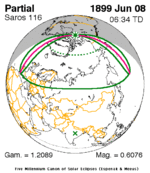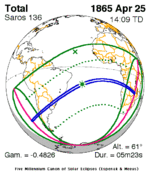Solar_eclipse_of_May_18,_1901
Solar eclipse of May 18, 1901
Total eclipse
A total solar eclipse occurred on May 18, 1901.[1][2][3][4] A solar eclipse occurs when the Moon passes between Earth and the Sun, thereby totally or partly obscuring the image of the Sun for a viewer on Earth. A total solar eclipse occurs when the Moon's apparent diameter is larger than the Sun's, blocking all direct sunlight, turning day into darkness. Totality occurs in a narrow path across Earth's surface, with the partial solar eclipse visible over a surrounding region thousands of kilometres wide. The path of totality crossed French Madagascar (the part now belonging to Madagascar), Réunion, British Mauritius (now Mauritius), Dutch East Indies (now Indonesia), and British New Guinea (now belonging to Papua New Guinea).




























